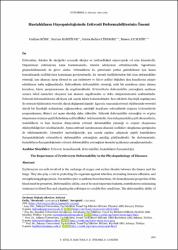Hastalıkların Fizyopatolojisinde Eritrosit Deformabilitesinin Önemi
Abstract
Eritrositler, dokular ile akciğerler arasında oksijen ve karbondioksit alışverişinde rol alan hücrelerdir.
Organizmayı enfeksiyona karşı korunmasında, immün adezyonun arttırılmasında, fagositozun
güçlendirilmesinde de görev alırlar. Eritrositlerin bu görevlerini yerine getirebilmesi için kanın
hemodinamik özelliklerinin korunması gerekmektedir. En önemli özelliklerinden biri olan deformabilite
yeteneği, kan akımına karşı direnci en aza indirmeye ve hücre şeklini değişken akış koşullarına adapte
edebilmeye katkı sağlamaktadır. Eritrositlerin deformabilite yeteneği, sabit bir membran yüzey alanını
korurken, hücre parçalanmasını da engellemektedir. Eritrositlerin deformabilite yeteneğinin azalması
sonucu kılcal damarları tıkayarak kan akımını engellemekte ve doku oksijenlenmesini azaltmaktadır.
Eritrosit deformabilitesini etkileyen çok sayıda faktör bulunmaktadır. Bazı etkilerin fizyolojik regülasyonu
ile eritrosit rijiditesinin reversibl olarak değişmesi olasıdır. Egzersiz esnasında eritrosit rijiditesinde reversibl
olarak bir fizyolojik mekanizma sağlanıyorken, patolojik koşulların eritrositlerde eriptoza (eritrositlerde
programlanmış ölüme) yol açma olasılığı daha yüksektir. Eritrosit deformabilite yeteneğini ve eriptoz
oluşumunu ortamın çeşitli fizikokimyasal özellikleri belirlemektedir. Kan dolaşımındaki çeşitli elementlerin,
moleküllerin ve bazı hormon düzeylerinin eritrosit deformabilite yeteneği ve eriptoz oluşumunu
etkileyebildiği ileri sürülmektedir. Ayrıca eritrosit membranının dinamik özellikleri sitoplazma içeriğinden
de etkilenmektedir. Literatürü incelediğimizde, çok sayıda yapılan çalışmada çeşitli hastalıkların
fizyopatolojisinde eritrositlerin deformabilite yeteneğinin azaldığı görülmektedir. Bu derlememizde,
hastalıkların fizyopatolojisinde eritrosit deformabilite yeteneğinin önemini açıklamayı amaçlanmaktadır. Erythrocytes are cells involved in the exchange of oxygen and carbon dioxide between the tissues and the
lungs. They also play a role in protecting the organism against infection, increasing immune adhesion, and
strengthening phagocytosis. For erythrocytes to perform these functions, the hemodynamic properties of the
blood must be preserved. Deformability ability, one of its most important features, contributes to minimizing
resistance to blood flow and adapting the cell shape to variable flow conditions. The deformability ability of erythrocytes prevents cell lysis while maintaining a constant membrane surface area. As a result of the
decrease in the deformability of erythrocytes, it clogs the capillaries, obstructing blood flow and reducing
tissue oxygenation. There are many factors affecting erythrocyte deformability. It is possible that erythrocyte
rigidity changes reversibly with physiological regulation of some effects. While a reversible physiological
mechanism is provided in erythrocyte rigidity during exercise, pathological conditions are more likely to
cause eryptosis (programmed cell death) in erythrocytes. Various physicochemical properties of the
environment determine the ability of erythrocyte deformability and eryptosis formation. It has been
suggested that various elements, molecules, and some hormone levels in the bloodstream may affect
erythrocyte deformability and eryptosis formation. In addition, the dynamic properties of the erythrocyte
membrane are also affected by the content of the cytoplasm. When we examine the literature, many studies
show that the deformability ability of erythrocytes is reduced in the physiopathology of various diseases. In
this review, we aim to explain the importance of erythrocyte deformability in the physiopathology of
diseases.

















